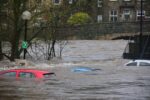Rainfall in NYC: Assessing the Challenges and the State of Emergency
Introduction
Rainfall is an essential component of the Earth’s climate system and plays a crucial role in sustaining life. However, when rainfall becomes excessively intense, it can result in numerous challenges and pose significant threats to human well-being and infrastructure. This report aims to analyze the recent intense rainfall events in New York City (NYC), assess the challenges they have posed, and discuss the implications of declaring a state of emergency.
The Intense Rainfall Events
In recent years, NYC has experienced a rise in extreme rainfall events, with records being broken for the highest rainfall totals in a single day. The most recent event, which occurred last week, brought torrential downpours and resulted in flash flooding across the city. The city saw almost double its average monthly rainfall in just a few hours, causing widespread disruption to transportation networks, flooding of streets, subways, and basements, and even the loss of life.
Infrastructure Vulnerabilities
The intense rainfall events expose vulnerabilities in NYC‘s infrastructure. The city’s aging stormwater management system struggles to cope with the rapid influx of water during heavy downpours. Combined sewer systems, which carry both wastewater and stormwater, become overwhelmed, leading to untreated sewage being discharged into local waterways. Additionally, outdated storm drains and inadequate street-level drainage exacerbate the flooding issues, causing significant damages to homes and businesses.
Climate Change and Intense Rainfall
The increase in intense rainfall events can be attributed, at least in part, to climate change. As global temperatures rise, the atmosphere can hold more moisture, resulting in heavier rainfall events. The scientific consensus on the link between climate change and extreme weather events is solidifying, with studies indicating that such events will become more frequent and intense in the future. This raises the need for urgent action to mitigate and adapt to the changing climate.
Declaring a State of Emergency
In response to the recent intense rainfall events, the mayor of NYC has declared a state of emergency. This declaration aims to mobilize resources, streamline response efforts, and provide necessary support to affected communities. However, it also raises questions about the effectiveness of such measures and the long-term approach to managing the impacts of climate change.
Immediate Response vs. Long-term Solutions
While declaring a state of emergency is a necessary step in addressing the immediate crisis, it should not be seen as a solution in itself. It is crucial for city officials to look beyond short-term fixes and focus on long-term strategies to mitigate the effects of intense rainfall in the future. This includes investing in modernizing and upgrading the stormwater infrastructure, improving street-level drainage systems, and implementing green infrastructure solutions such as rain gardens and permeable pavements.
Rethinking Urban Planning
The recent rainfall events also highlight the importance of reevaluating urban planning strategies. Building codes and regulations need to be updated to account for the changing climate conditions, ensuring that all new developments are resilient to extreme weather events. This could involve changes to building designs, incorporating more green spaces, and creating flood-resistant infrastructure.
Public Awareness and Education
In addition to infrastructure improvements, raising public awareness about the impacts of intense rainfall and climate change is essential. Education campaigns can help individuals understand the steps they can take to mitigate risks and adapt their homes and lifestyles. This could include initiatives such as promoting the use of rain barrels, encouraging the installation of basement flood prevention systems, and facilitating community workshops on emergency preparedness.
Conclusion
The recent intense rainfall events in NYC and the subsequent declaration of a state of emergency highlight the urgent need for comprehensive action to address the challenges posed by climate change and the associated consequences. Balancing short-term emergency responses with long-term infrastructure upgrades and fundamental changes in urban planning will be crucial to ensuring the resilience and well-being of NYC‘s residents. By embracing innovative strategies and fostering public education, NYC has the potential to become a role model for other cities facing similar challenges. Time is of the essence, and proactive measures are essential to build a more resilient and sustainable future for all.

<< photo by Dids >>
The image is for illustrative purposes only and does not depict the actual situation.
You might want to read !
- The Impact of Brian Branch’s Injury on the Detroit Lions: A Closer Look at the Star Player’s Status
- Shooting for the Stars: The Sprouting Hope of Sycamore Gap
- Governor Katie Hobbs Joins Announcement of Construction of the Future: Building Progress for a Better Arizona
- Messi’s Potential Arrival Inspires Confidence in Inter Miami’s Coach despite US Open Cup Loss
- The Evolution of Blink-182: Analyzing the Emotional Depth of their New Music Video
- 2024 U.S. Olympic Team: Who Will Secure Their Spots at the New York City Marathon?
- “Governor Newsom Proclaims State of Emergency As Hurricane Threatens California Coast”
- Amidst Drought and Wildfires, Gov. Newsom Declares State of Emergency in Southern California: A Race Against Nature
- Block Island’s Historic Hotel Engulfed in Flames: A State of Emergency Declared
- Record-breaking astronaut Frank Rubio finally returns to Earth after an extraordinary year in space: Exploring the limits of human endurance and paving the way for future missions
- “Coming Full Circle: The Triumph and Return of NASA’s Record-Breaking Astronaut, Frank Rubio”
- Concussion Evaluation: Examining the Impact on Packers’ Luke Musgrave
- Can CVS Keep Its Promises? Assessing the End of the Walkout.
- ‘Til Paradise Do Us Part: A Look at the Lasting Love on ‘Bachelor in Paradise’




